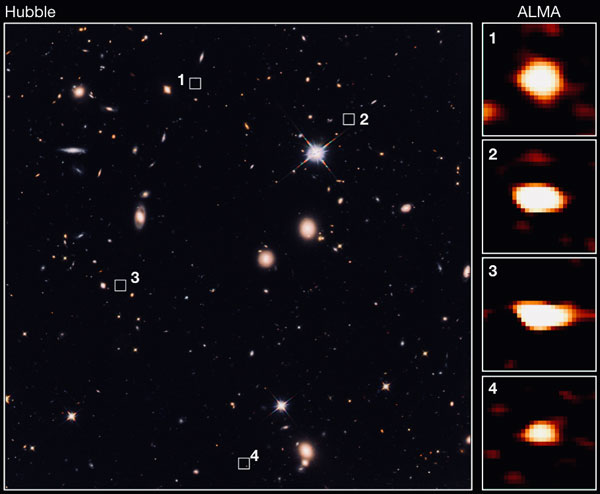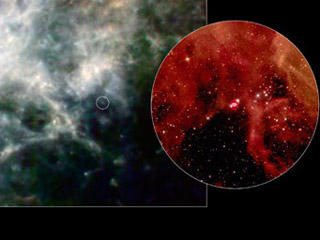Astronomers have discovered galaxies that have escaped detection until now, uncovering a missing link in galaxy evolution. The find suggests that we don’t understand galaxy formation as well as we thought we did.
In deep observations that dig into the earliest eras of the universe, astronomers have excavated the ancestors of modern-day massive galaxies. These dusty galaxies are bursting with stars — but they’re invisible at the wavelengths astronomers typically probe.

University of Tokyo / CEA / NAOJ
Astronomers have spent years observing a small window of sky with the Hubble and Spitzer Space Telescopes, among other facilities. The survey, dubbed Cosmic Assembly Near-infrared Deep Extragalactic Legacy Survey (CANDELS), samples hundreds of thousands of galaxies at cosmic dawn — when galaxies first appeared — through cosmic noon, when most of the stars we see today formed. Now, a new study published in the August 7th Nature reveals a couple dozen galaxies emitting submillimeter-wavelength radiation. They represent a missing link in galaxy evolution.
Tao Wang (University of Tokyo, French Alternative Energies and Atomic Energy Commission, and the National Astronomical Observatory of Japan) and colleagues focused on 63 infrared-bright galaxies detected in the CANDELS field. Although the Spitzer Space Telescope had detected infrared radiation from these sources, they disappear when viewed through near-visible wavebands. (Specifically, the galaxies go dark beginning with the H-band filter, which is centered at 1,650 nanometers.) Wang and his team observed each galaxy using the Atacama Large Millimeter/submillimeter Array (ALMA) in Chile. They made bank on 39 of them, detecting those galaxies at submillimeter wavelengths.
The ALMA observations show that these optically invisible galaxies are bursting with new stars, forming at roughly 200 times the rate in the Milky Way. But these newborn stars are so heavily shrouded in dust they’re invisible except at very long wavelengths.
That leaves a question, muses Allison Kirkpatrick (University of Kansas), an expert in galaxy evolution who was not involved in the study: Where did all this dust come from?
The Dust’s the Thing

ESA / NASA-JPL / UCL / STScI
The newly discovered galaxies reside in the universe between 1 billion and 3 billion years after the Big Bang, a time between “dawn” and “noon” (a cosmic elevenses, if you will). During this time, star formation was ramping up across the cosmos, and starbirth also means stardeath. Dust forms in the aftermath of supernova explosions but, Kirkpatrick notes, astronomers didn’t think there would have been enough supernovae to produce so much dust so soon.
Since astronomers weren’t expecting dust, they weren’t expecting “invisible” galaxies. Newborn stars are brightest at ultraviolet wavelengths, but the expanding universe will stretch the wavelengths of photons from more distant galaxies. A galaxy might appear bright at optical or even near-infrared wavelengths if it’s far enough away. Regardless, if there’s no dust, then we should be able to see galaxies near and far using just ultraviolet, optical, and near-infrared wavelengths.
Observations at submillimeter wavelengths had turned up galaxies before now, but these had been the extreme stellar factories churning out thousands of stars per year. Those galaxies, while fascinating, are rare. The dim, shrouded galaxies that Wang’s team saw, though, are common enough that they could represent the ancestors of massive, elliptical galaxies that we see in today’s universe.
Results such as this one, though, suggest that the young universe is more dusty than we thought. “This means we do not understand star formation in the early universe,” says Kirkpatrick. “Theory is, as of this paper, based on outdated observations.”
Our understanding of galaxy formation, it seems, is up for major revision.
 9
9









Comments
Anthony Barreiro
August 13, 2019 at 2:48 pm
Cosmic elevenses would be characterized by the presence of complex organic chemicals such as theaflavins and a brief lull in star formation activity.
You must be logged in to post a comment.
Klarn Mxyzptlk
August 14, 2019 at 1:42 pm
When will "Astronomy" finally admit that all of its claims about "outer space" are all imaginary and invented? The distances and sizes of the objects its proponents insist they see are ALL invented. None are known by actual measurement because none of them have been there to do the measuring. It must be awful to be a professional liar in order to keep a paycheck coming.
You must be logged in to post a comment.
equusmtn
August 18, 2019 at 2:15 pm
The world is full of professional liars; it's a lucrative business. Pundits on certain "news" networks come to mind, and also weather forecasters, although in defense of the latter, they're doing the best they can. I think that, as scientists, astronomers are doing the best they can, too, and I have a great deal of faith in them.
Anyway, Klarn, say hi to Superman for us.
You must be logged in to post a comment.
Rod
August 16, 2019 at 1:53 pm
Wow, this is quite a claim here folks. "When will “Astronomy” finally admit that all of its claims about “outer space” are all imaginary and invented? The distances and sizes of the objects its proponents insist they see are ALL invented." The view expressed here sounds similar to flat earth teaching I encounter from time to time. Geocentric astronomy like Claudius Ptolemy and Tycho Brahe did indeed have a small universe with objects nearby the *immovable earth* including the Sun much closer than the modern, heliocentric solar system. In 1672, the Mars parallax was measured by Cassini using telescopes showing the distance between Earth and Mars. In 1838, the first stellar parallax for the star 61 Cygni was established, close to 11 light-years distance from Earth. The lunar parallax shows the distance between the Earth and the Moon and in the 1700s and 1800s, the solar parallax determined the distance between the Earth and the Sun using Venus and Mercury transits. Asteroid parallax measurements show their distances and orbits too. Hipparcos and Gaia satellites show stellar parallax for thousands of stars out to distance of some 1500 light-years or more. Yes, there are various distance extrapolations used today that do not use stellar parallax measurements but claiming all the distances and sizes for objects in astronomy, e.g. Jupiter or Saturn or the distance to the Sun is not knowable, is nonsense.
You must be logged in to post a comment.
chalkfullofhits
August 20, 2019 at 11:11 pm
It seems to be another case of "I'm not able to understand the math or science involved, therefore I must question its validity."
You must be logged in to post a comment.
postrevolutionary
August 16, 2019 at 4:24 pm
"In the space of one hundred and seventy-six years the Lower Mississippi has shortened itself two hundred and forty-two miles. That is an average of a trifle over one mile and a third per year. Therefore, any calm person, who is not blind or idiotic, can see that in the Old Oolitic Silurian Period, just a million years ago next November, the Lower Mississippi River was upwards of one million three hundred thousand miles long, and stuck out over the Gulf of Mexico like a fishing-rod. And by the same token any person can see that seven hundred and forty-two years from now the Lower Mississippi will be only a mile and three-quarters long, and Cairo and New Orleans will have joined their streets together, and be plodding comfortably along under a single mayor and a mutual board of aldermen. There is something fascinating about science. One gets such wholesale returns of conjecture out of such a trifling investment of fact." —Mark Twain
You must be logged in to post a comment.
Rod
August 16, 2019 at 8:31 pm
The quote from Mark Twain produced by the flat earth community here I agree with. The geology measurements are very different and *not as reliable* as the distance measurement for the Moon, Mars, or the Sun in the heliocentric solar system by parallax measurements determined by telescopes 🙂
You must be logged in to post a comment.
dgjohnsonstein
August 16, 2019 at 9:22 pm
I'm sorry, but you don't make any sense. Care to try again?
You must be logged in to post a comment.
Rod
August 17, 2019 at 6:55 am
The flat earth community quote of Mark Twain mixes apples and oranges in measurement and methods, attempting to show that astronomy measurements are all wrong and unreliable, including the distance between the Earth and Sun as an example. The S&T report cites 7th of August Nature article. The Nature article says "Here we report submillimetre (wavelength 870 micrometres) detections of 39 massive star-forming galaxies at z > 3..." The Sky & Telescope report stated "The newly discovered galaxies reside in the universe between 1 billion and 3 billion years after the Big Bang, a time between “dawn” and “noon” (a cosmic elevenses, if you will).
Q: Based upon the Big Bang model using the Hubble time and Hubble constant, is this interpretation of the galaxy redshifts (z >3) and star formation history a reliable and secure measurement?
You must be logged in to post a comment.
You must be logged in to post a comment.